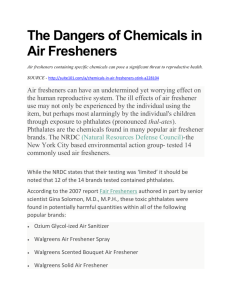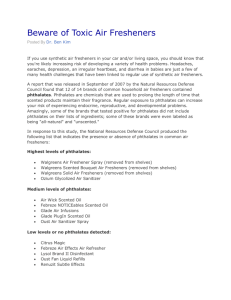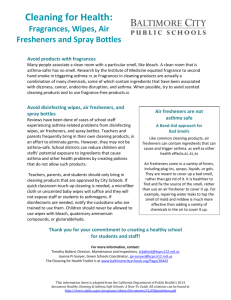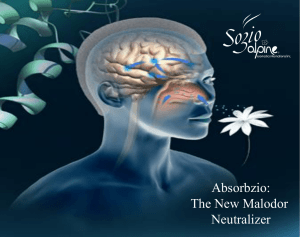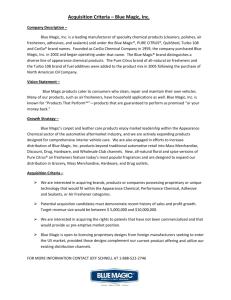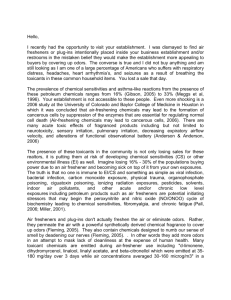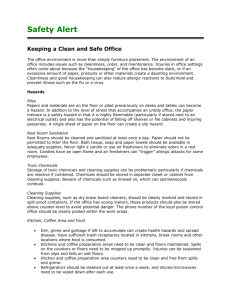how air fresheners are killing you
advertisement
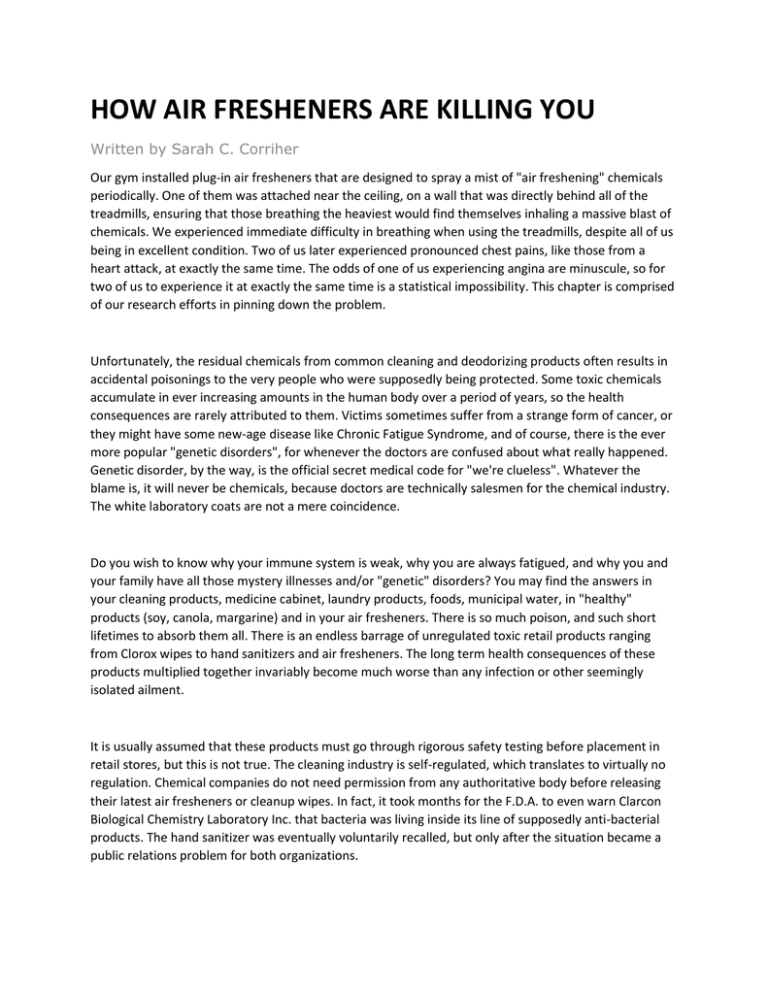
HOW AIR FRESHENERS ARE KILLING YOU Written by Sarah C. Corriher Our gym installed plug-in air fresheners that are designed to spray a mist of "air freshening" chemicals periodically. One of them was attached near the ceiling, on a wall that was directly behind all of the treadmills, ensuring that those breathing the heaviest would find themselves inhaling a massive blast of chemicals. We experienced immediate difficulty in breathing when using the treadmills, despite all of us being in excellent condition. Two of us later experienced pronounced chest pains, like those from a heart attack, at exactly the same time. The odds of one of us experiencing angina are minuscule, so for two of us to experience it at exactly the same time is a statistical impossibility. This chapter is comprised of our research efforts in pinning down the problem. Unfortunately, the residual chemicals from common cleaning and deodorizing products often results in accidental poisonings to the very people who were supposedly being protected. Some toxic chemicals accumulate in ever increasing amounts in the human body over a period of years, so the health consequences are rarely attributed to them. Victims sometimes suffer from a strange form of cancer, or they might have some new-age disease like Chronic Fatigue Syndrome, and of course, there is the ever more popular "genetic disorders", for whenever the doctors are confused about what really happened. Genetic disorder, by the way, is the official secret medical code for "we're clueless". Whatever the blame is, it will never be chemicals, because doctors are technically salesmen for the chemical industry. The white laboratory coats are not a mere coincidence. Do you wish to know why your immune system is weak, why you are always fatigued, and why you and your family have all those mystery illnesses and/or "genetic" disorders? You may find the answers in your cleaning products, medicine cabinet, laundry products, foods, municipal water, in "healthy" products (soy, canola, margarine) and in your air fresheners. There is so much poison, and such short lifetimes to absorb them all. There is an endless barrage of unregulated toxic retail products ranging from Clorox wipes to hand sanitizers and air fresheners. The long term health consequences of these products multiplied together invariably become much worse than any infection or other seemingly isolated ailment. It is usually assumed that these products must go through rigorous safety testing before placement in retail stores, but this is not true. The cleaning industry is self-regulated, which translates to virtually no regulation. Chemical companies do not need permission from any authoritative body before releasing their latest air fresheners or cleanup wipes. In fact, it took months for the F.D.A. to even warn Clarcon Biological Chemistry Laboratory Inc. that bacteria was living inside its line of supposedly anti-bacterial products. The hand sanitizer was eventually voluntarily recalled, but only after the situation became a public relations problem for both organizations. These voluntary recalls are the most common type, and the term 'voluntary' indicates that the F.D.A. officially informed the guilty corporation that it would not take any action against them, regardless of what the corporation did about the situation. The phrase 'voluntary recall' seriously means this in the food and pharmaceutical industries. Air fresheners are thought to be even further outside the jurisdiction of regulators than most products. To its credit, the State of California forces labeling of ingredients that are known to cause cancer or reproductive harm, under Proposition 65, but this is the entirety of this industry's regulations. Do not be fooled into thinking that you are safe just because your product appeared on your retailer's shelf. To the contrary, common chemical products are increasingly shown in studies to cause serious health problems, and it is impossible to test for truly long term problems. The Natural Resources Defense Council (NRDC) studied the effects of air fresheners, discovering that they currently undergo no safety testing. The results were disturbing, because they revealed high levels of phthalates, which are known to be especially harmful to children. These chemicals were even present in sprays which were claimed to be "All-Natural" and "unscented". Phthalates were not disclosed in the list of ingredients for any of the products. "Phthalates are hormone-disrupting chemicals that can be particularly dangerous for young children and unborn babies. Exposure to phthalates can affect testosterone levels and lead to reproductive abnormalities, including abnormal genitalia and reduced sperm production. The State of California notes that five types of phthalates -- including one that we found in air freshener products -- are 'known to cause birth defects or reproductive harm.'" -- Natural Resources Defense Council 1,4-Dichlorobenzene (1,4,-DCB) is a chemical which can be found in the blood of 96% of Americans. It has been linked to lung damage, is a known carcinogen, and it is an EPA-registered pesticide. Studies found it to increase rates of asthma. It can be found in the majority of air fresheners, toilet deodorizers, and mothballs. It works by attacking the receptors in the nose, and thus eliminating the sense of smell. This is how the new generation of air fresheners actually "freshen". These were introduced into the American market with the Febreze product from Proctor & Gamble. The recent generation of air fresheners that were inspired by the success of Febreze are literally using chemical warfare to destroy their customer's sense of smell. That lack of smell is where the illusion of "freshness" comes from. The user only smells these air fresheners for about the first minute after they have been sprayed, and then the nose cannot smell most fragrances anymore. This is not a normal adjustment to odors, nor would be a loss of one of the other four senses. The process is the equivalent to using a chemical blinding agent to escape the unpleasantness of a bright light; when that chemical is known to be both poisonous and carcinogenic. The chemical causes intentional damage to the nose, which is claimed to be temporary. However, no long term studies have ever been done to test the effects of chronic exposure. It is important to remember that anything inhaled is immediately absorbed into the blood through the lungs relatively unchanged. Dichlorobenzene is, in large part, the reason why so many pet birds die directly after the use of air fresheners. Due to hundreds of reports of bird deaths on the Internet, Procter & Gamble (Febreze manufacturer) funded its own internal study into this, and (without surprise) concluded that there are no safety issues whatsoever concerning pet birds, or human beings. Dichlorobenzene is the main ingredient used to manufacture the infamous pesticide DDT, and its cousins, DDE and DDD. Chlorine alone has a tendency to form DDT and DDT-like compounds when it reacts with many other substances. Such chlorine compounds disrupt the endocrine system by destroying hormones throughout a body, in a similar manner to BPA; but in a much more powerful way. Sometimes the result of exposure is horrific health problems that never completely disappear. It may help readers to put the situation into perspective by being made aware that their use of most air freshener brands is the literal practice of inhaling small amounts of DDT. Inhalation is more dangerous than oral ingestion of the same amount. "Problems associated with DDT, as well as many chlorinated hydrocarbons, involved their tendency to concentrate in the fat of humans, livestock, aquatic food chains, and wildlife. This latter phenomena, called bioaccumulation, has had, and continues to have, severe adverse effects on many forms of wildlife... "Since implementation of [the DDT ban], residues of the pesticides have significantly decreased in many regions where they were formerly used. However, DDT, DDD and DDE persist in the environment for a very long time. DDT, DDD and DDE residues can still be found in most areas of the United States"... [80 years later] -- The U.S. Fish and Wildlife Service The issues of synthetic fragrances have been around for years, and has led to many companies selling 'unscented' options. These fragrances cause changes in blood flow, blood pressure, mood, and trigger migraine headaches. A massive 72% of asthmatics cite these fragrances as a trigger in causing asthma attacks, and they have been implicated as a cause for the initial development of asthma. Asthma rates in the United States have doubled since 1980, and the use of air fresheners has doubled since just 2003. Most synthetic fragrances are also known 'respiratory irritants', which means that they cause inflammation in the lungs, leading to an increased mucous production, and a greater vulnerability to other chemicals, allergens, and viruses. Ninety-five percent of synthetic fragrances are derived from petroleum. They include benzene and aldehydes; which are known to cause cancers, reproductive effects, and problems with the central nervous system. These effects on the nervous system result in increased cases of Alzheimer's disease, multiple sclerosis, Parkinson's disease, and more. A study from 1991 entitled, 'Chemical Exposures: Low Levels and High Stakes', tested the effects of fragrances among test subjects. When asthmatics were exposed to cologne for 10 minutes, their pulmonary functions were impaired by a whopping 58% from a previous 18% handicap. Of the 60 asthmatics that they surveyed, 57 complained of respiratory symptoms with exposure to common scents. Phthalates, like those found in air freshener mists, are usually used in the production of P.V.C plastics. All air fresheners containing phthalates lack any labeling to indicate their presence. Phthalates are also found in air fresheners that were labeled "unscented" and "all natural". With an estimated 75% of consumers using air fresheners in their homes, we strongly recommend improving ventilation systems to dilute these chemicals as much as possible, if they cannot be eliminated altogether. According to the Environmental Working Group, phthalates produce liver cancer, but this link has not been 'officially' acknowledged by regulatory agencies. The chemicals which are emitted from air fresheners (and other toxic products) accumulate in the fatty tissues over time, so the dangers increase as they build up inside a body over time. The presence of toxins inside fat can make weight loss difficult. Since the human body uses fat to store certain materials that are too toxic for it to process, breaking down the fat would mean releasing those toxins, so a body must resist its fat loss for self-defense. Thus, fat is sometimes the result of an immune system properly responding to a danger. Sooner or later, society will have to step back and revert to old-fashioned means of cleaning, cooking, and keeping our homes smelling good. That will include the removal of non-stick pans, air fresheners, and hand sanitizers. While they may make certain tasks easier, avoiding them is an essential step to ensure a long, healthy life for your family. Since children are most at risk, we can only hope that those reading this article will dispose of their air fresheners, to minimize the exposure of those who are not able to protect themselves.
